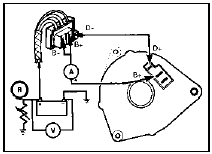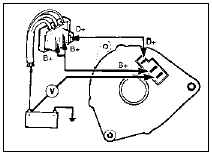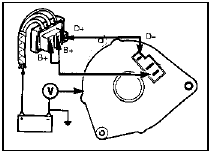Alternator - testing
Note: To carry out the complete test procedure use only the following test equipment - a 0 to 20 volt moving coil voltmeter, a 0 to 100 amp moving coil ammeter, and a rheostat rated at 30 amps.
1 Check that the battery is at least 70% charged by using a hydrometer.
2 Check the drivebelt tension.
3 Check the security of the battery leads, alternator multi-plug, and interconnecting wire.
Cable continuity check
4 Pull the multi-plug from the alternator and
switch on the ignition, being careful not to crank
the engine. Connect the voltmeter between a
good earth and each of the terminals in the
multi-plug in turn. If battery voltage is not
indicated, there is an open circuit in the wiring
which may be due to a blown ignition warning
light bulb if on the small terminal.
Alternator output check
5 Connect the voltmeter, ammeter and
rheostat as shown (see illustration).

6.5 Alternator output test circuit
Run the engine at 3000 rpm and switch on the headlamps, heater blower and, where fitted, the heated rear window. Vary the resistance to increase the current and check that the alternator rated output is reached without the voltage dropping below 13 volts.
Charging circuit positive side
check
6 Connect the voltmeter as shown (see
illustration).

6.6 Alternator positive check circuit
Start the engine and switch on the headlamps. Run the engine at 3000 rpm and check that the indicated voltage drop does not exceed 0.5 volt. A higher reading indicates a high resistance such as a dirty connection on the positive side of the charging circuit.
Charging circuit negative side
check
7 Connect the voltmeter as shown (see
illustration).

6.7 Alternator negative check circuit
Start the engine and switch on the headlamps. Run the engine at 3000 rpm and check that the indicated voltage drop does not exceed 0.25 volt. A higher reading indicates a high resistance such as a dirty connection on the negative side of the charging circuit.
Voltage regulator check
8 Connect the voltmeter and ammeter as
shown (see illustration).

6.8 Alternator voltage regulator test circuit
Run the engine at
3000 rpm and when the ammeter records a
current of 3 to 5 amps check that the voltmeter
records 13.7 to 14.15 volts. If the result is
outside the limits the regulator is faulty.
See also:
Ignition timing - adjustment for use with unleaded petrol
Note: Refer to the Specifications Section at
the beginning of this Chapter for ignition
timing values for use with unleaded petrol.
1 To run an engine on unleaded petrol,
certain criteria must be ...
Engine oil and filter renewal (Every 6000 miles (10 000 km) or 6 months)
1 Frequent oil and filter changes are the most
important preventative maintenance
procedures which can be undertaken by the
DIY owner. As engine oil ages, it becomes
diluted and contaminated, whic ...
Safety restraints for children
See the following sections for directions on how to properly use safety
restraints for children. Also see Air bag supplemental restraint system
(SRS) in this chapter for special instructions about u ...
